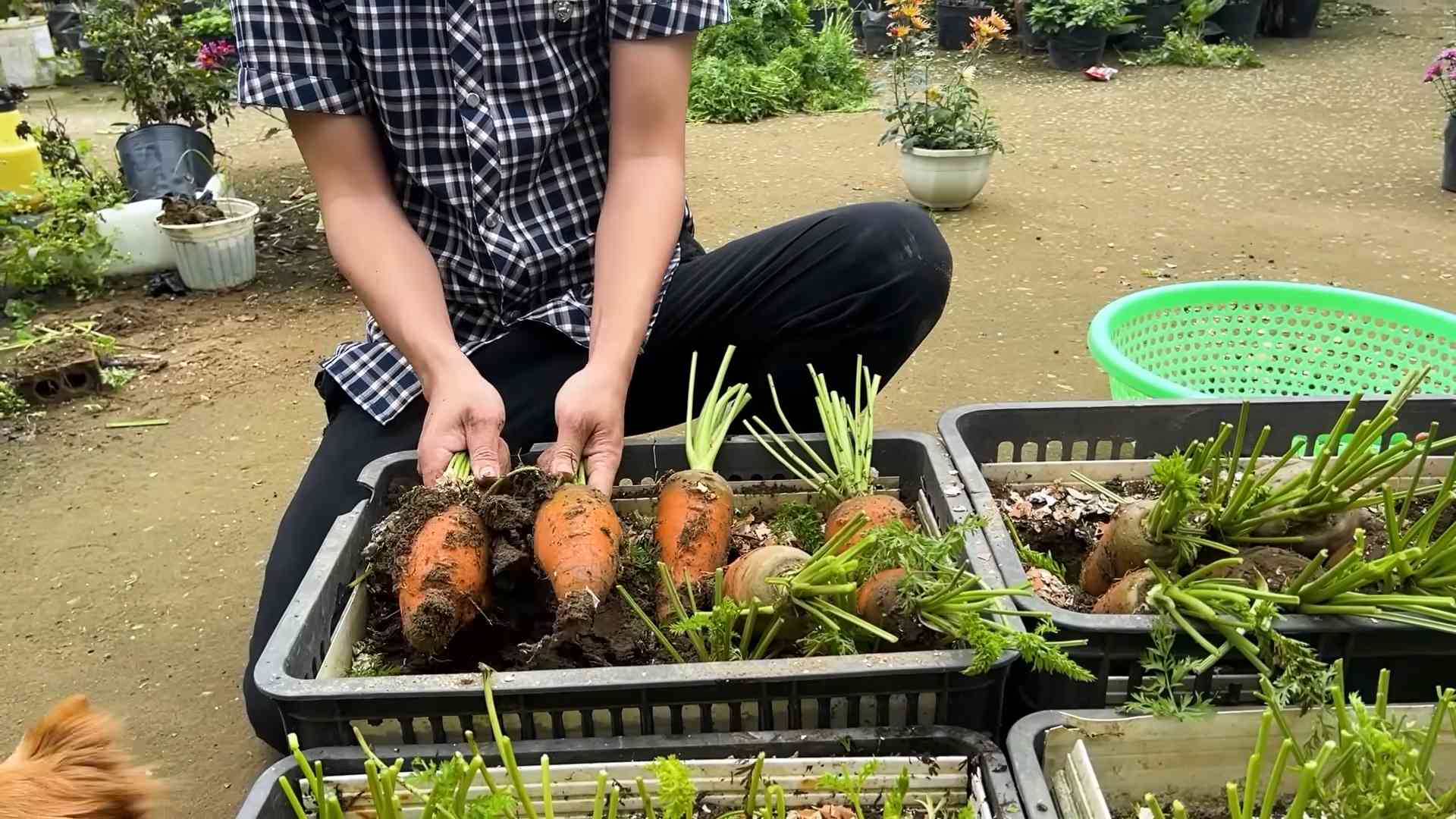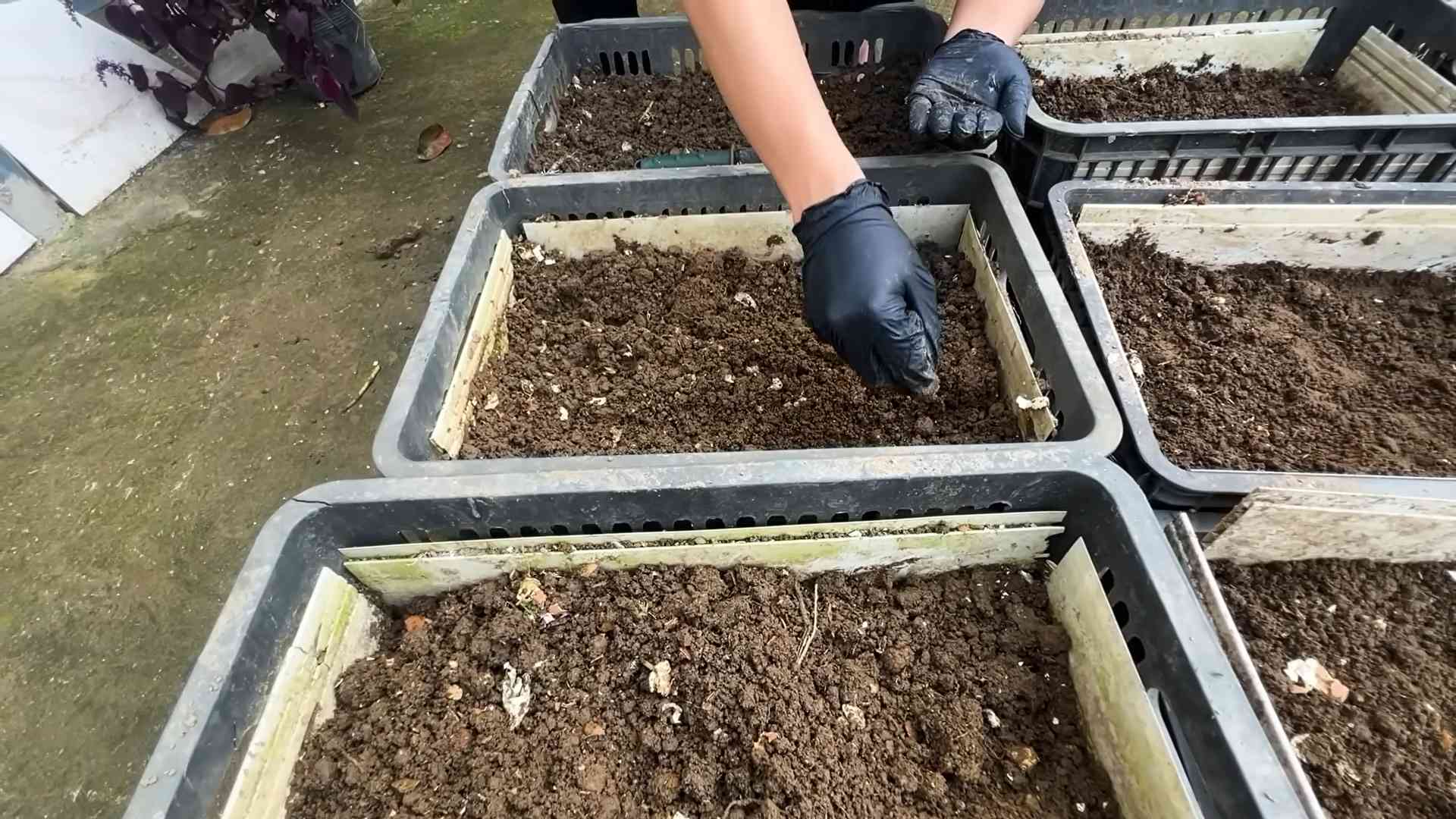Grow Carrots at Home – and unlock the secrets to the freshest, sweetest carrots you’ve ever tasted! Imagine plucking vibrant orange carrots straight from your backyard, still warm from the sun. No more bland, store-bought veggies; just crisp, flavorful goodness grown with your own two hands.
For centuries, carrots have been a staple in diets around the world. Originating in Central Asia, these root vegetables were initially cultivated for their aromatic leaves and seeds, not their roots! Over time, through careful selection and cultivation, the familiar orange carrot we know and love emerged. Today, growing your own carrots is a way to connect with this rich agricultural history and enjoy the fruits (or rather, roots!) of your labor.
Why should you learn these DIY tricks for growing carrots at home? Well, let’s face it, store-bought carrots often lack that intense, earthy sweetness. Plus, knowing exactly where your food comes from and how it’s grown is incredibly empowering. This article will guide you through simple, effective techniques to ensure a bountiful carrot harvest, even if you have limited space. I’m going to show you how to avoid common pitfalls, choose the right varieties, and create the perfect growing environment. Get ready to transform your garden (or even a sunny windowsill!) into a carrot-growing paradise!

Growing Carrots at Home: A Beginner’s Guide
Hey there, fellow gardening enthusiasts! Ever dreamt of pulling vibrant, crunchy carrots straight from your own backyard? Well, dream no more! Growing carrots at home is surprisingly easy and rewarding, even if you’re a complete newbie. I’m going to walk you through everything you need to know, from choosing the right variety to harvesting your delicious bounty. Let’s get digging!
Choosing the Right Carrot Variety
First things first, let’s talk carrots! Not all carrots are created equal, and choosing the right variety for your space and climate is crucial. Here’s a breakdown of some popular options:
* Nantes: These are classic, cylindrical carrots with a sweet flavor and smooth skin. They’re relatively short (around 6-7 inches) and mature quickly, making them a great choice for beginners.
* Danvers: These are longer, tapered carrots with a slightly stronger flavor. They’re known for their good storage capabilities.
* Chantenay: These are short, thick, and almost cone-shaped. They’re perfect for heavy or rocky soils, as they don’t need as much depth to grow.
* Baby Carrots: If you’re short on space or just want a quick harvest, consider growing baby carrot varieties. They mature in as little as 50 days.
* Heirloom Varieties: For a bit of fun, explore heirloom varieties like ‘Purple Haze’ or ‘Yellowstone’. They offer unique colors and flavors.
My Recommendation: If you’re just starting out, I highly recommend Nantes or Chantenay varieties. They’re relatively forgiving and easy to grow.
Preparing Your Carrot Patch
Carrots are a bit picky about their soil. They need loose, well-drained soil that’s free of rocks and clumps. Rocky soil can cause the roots to fork or become stunted. Here’s how to prepare your carrot patch:
1. Choose a Sunny Spot: Carrots need at least 6 hours of sunlight per day.
2. Clear the Area: Remove any weeds, rocks, or debris from the planting area.
3. Loosen the Soil: This is the most important step! Use a garden fork or tiller to loosen the soil to a depth of at least 12 inches. Break up any large clumps of soil.
4. Amend the Soil: Carrots prefer slightly acidic soil (pH 6.0-6.8). Amend the soil with compost or well-rotted manure to improve drainage and fertility. Avoid using fresh manure, as it can cause the roots to fork.
5. Create Raised Beds (Optional): If your soil is heavy or poorly drained, consider creating raised beds. This will improve drainage and make it easier to control the soil quality.
6. Smooth the Surface: Rake the soil to create a smooth, even surface. This will make it easier to sow the seeds evenly.
Pro Tip: Add some sand to the soil if it’s particularly heavy or clay-like. This will improve drainage and prevent the carrots from becoming waterlogged.
Sowing Carrot Seeds
Carrot seeds are tiny, so sowing them evenly can be a bit of a challenge. But don’t worry, I’ve got some tips to help you out:
1. Check the Planting Time: Carrots are a cool-season crop, so they’re best planted in early spring or late summer. Check your local planting calendar for the best time to sow seeds in your area.
2. Create Furrows: Use a hoe or your finger to create shallow furrows in the soil, about 1/4 to 1/2 inch deep. Space the furrows about 2-3 inches apart.
3. Sow the Seeds: Sprinkle the carrot seeds evenly along the furrows. Don’t sow them too thickly, as this will make it difficult to thin them later.
4. Cover the Seeds: Gently cover the seeds with a thin layer of soil.
5. Water Gently: Water the soil gently with a watering can or hose with a gentle spray nozzle. Be careful not to wash away the seeds.
6. Keep the Soil Moist: Keep the soil consistently moist until the seeds germinate. This may require watering daily, especially in warm weather.
My Trick for Even Sowing: Mix the carrot seeds with sand before sowing. This will help you spread them more evenly.
Caring for Your Carrot Plants
Once your carrot seeds have germinated, it’s time to start caring for your plants. Here’s what you need to do:
1. Thin the Seedlings: This is crucial for healthy carrot growth. When the seedlings are about 2 inches tall, thin them to about 1-2 inches apart. Use scissors to snip off the unwanted seedlings at the soil line, rather than pulling them out, as this can disturb the roots of the remaining plants.
2. Water Regularly: Carrots need consistent moisture to grow properly. Water them deeply whenever the soil feels dry to the touch. Avoid overwatering, as this can lead to root rot.
3. Weed Regularly: Weeds can compete with carrots for nutrients and water, so it’s important to keep your carrot patch weed-free. Gently pull out any weeds that appear, being careful not to disturb the carrot roots.
4. Fertilize (Optional): If your soil is poor, you can fertilize your carrots with a balanced fertilizer. Follow the instructions on the fertilizer package. Avoid using fertilizers that are high in nitrogen, as this can cause the tops to grow too quickly and the roots to be small.
5. Mulch (Optional): Mulching around your carrot plants can help to retain moisture, suppress weeds, and regulate soil temperature. Use organic mulches like straw, hay, or wood chips.
Dealing with Pests: Carrots can be susceptible to pests like carrot rust flies and aphids. Inspect your plants regularly for signs of infestation. If you find pests, you can try using insecticidal soap or neem oil to control them.
Harvesting Your Carrots
The moment you’ve been waiting for! Harvesting your carrots is the most rewarding part of the process. Here’s how to do it:
1. Check the Maturity Date: Check the seed packet for the maturity date of your carrot variety. This will give you an idea of when your carrots will be ready to harvest.
2. Look for Size: Carrots are typically ready to harvest when they reach the desired size for their variety. You can gently brush away the soil around the top of the carrot to check its size.
3. Loosen the Soil: Before pulling the carrots, loosen the soil around them with a garden fork. This will make it easier to pull them out without breaking them.
4. Pull the Carrots: Grasp the carrot tops firmly and gently pull the carrots straight up out of the ground.
5. Wash and Store: Wash the carrots thoroughly to remove any dirt. Store them in the refrigerator in a plastic bag or container. They should keep for several weeks.
Harvesting Tip: If the soil is very dry, water the carrots a few hours before harvesting. This will make it easier to pull them out.
Troubleshooting Common Carrot Problems
Even with the best care, you might encounter some problems while growing carrots. Here are some common issues and how to address them:
* Forked Roots: This is usually caused by rocky or compacted soil. Make sure to prepare your soil properly before planting.
* Small Roots: This can be caused by overcrowding, poor soil, or lack of sunlight. Thin your seedlings properly, amend the soil with compost, and make sure your carrots are getting enough sunlight.
* Bitter Taste: This can be caused by hot weather or inconsistent watering. Keep the soil consistently moist and provide shade during the hottest part of the day.
* Cracked Roots: This can be caused by inconsistent watering. Water your carrots regularly and deeply, especially during dry spells.
* Pests and Diseases: Inspect your plants regularly for signs of pests or diseases. Use appropriate control measures, such as insecticidal soap or neem oil, to address any problems.
Don’t Give Up! Gardening is a learning process. Don’t be discouraged if you encounter problems along the way. Just keep learning and experimenting, and you’ll eventually be rewarded with a bountiful harvest of delicious carrots.
Extending Your Carrot Harvest
Want to enjoy fresh carrots for as long as possible? Here are a few tips for extending your harvest:
* Succession Planting: Sow carrot seeds every 2-3 weeks to ensure a continuous harvest throughout the growing season.
* Cold Frames or Row Covers: Use cold frames or row covers to protect your carrots from frost and extend the growing season into the fall and winter.
* Overwintering: In mild climates, you can overwinter carrots in the ground. Cover them with a thick layer of mulch to protect them from the cold.

Conclusion
So, there you have it! Growing carrots at home, while it might seem daunting at first, is surprisingly achievable and incredibly rewarding. We’ve walked you through the essential steps, from selecting the right carrot varieties to nurturing your seedlings and finally, harvesting those vibrant, homegrown delights. But why should you bother with this DIY project when carrots are readily available at the grocery store? The answer lies in the unparalleled freshness, the superior flavor, and the sheer satisfaction of nurturing something from seed to table.
Think about it: store-bought carrots often travel long distances, losing valuable nutrients and flavor along the way. When you grow your own, you’re enjoying carrots at their peak, bursting with sweetness and packed with vitamins. Plus, you have complete control over the growing process, ensuring that your carrots are free from harmful pesticides and chemicals. This is especially important if you’re conscious about eating organically and providing your family with the healthiest possible food.
Beyond the health benefits, growing your own carrots is a fantastic way to connect with nature, learn about the growing cycle, and even get some exercise in the process. It’s a therapeutic activity that can reduce stress and boost your mood. And let’s not forget the educational aspect – it’s a wonderful project to involve children in, teaching them about where their food comes from and fostering a love for gardening.
But the real magic of growing carrots at home lies in the possibilities for customization. Don’t be afraid to experiment with different varieties. Try growing colorful carrots like purple haze or yellow sun for a visually stunning addition to your salads. Or, if you’re short on space, consider growing shorter, round varieties like Parisian carrots in containers. You can also adjust the planting schedule to ensure a continuous harvest throughout the growing season.
Consider companion planting to enhance your carrot crop. Planting onions or garlic nearby can deter carrot root flies, while rosemary can repel carrot flies and cabbage moths. Marigolds are also excellent companions, attracting beneficial insects that prey on pests.
And speaking of pests, be vigilant about monitoring your carrot patch for any signs of trouble. Early detection and intervention are key to preventing infestations from ruining your crop. Use organic pest control methods whenever possible, such as hand-picking pests or using insecticidal soap.
Growing carrots at home is more than just a gardening project; it’s an investment in your health, your well-being, and your connection to the natural world. It’s a chance to experience the joy of harvesting your own food and sharing it with loved ones.
So, what are you waiting for? Grab some carrot seeds, prepare your garden bed, and get ready to embark on this exciting adventure. We’re confident that you’ll be amazed by the results. And once you’ve harvested your first batch of homegrown carrots, we encourage you to share your experience with us. Tell us about your successes, your challenges, and any tips or tricks you’ve learned along the way. Let’s create a community of home gardeners who are passionate about growing their own food and sharing their knowledge with others.
We can’t wait to hear about your carrot-growing journey! Happy gardening!
Frequently Asked Questions (FAQ)
What is the best time of year to plant carrots?
The best time to plant carrots depends on your climate. In general, carrots are a cool-season crop, so they thrive in temperatures between 60°F and 70°F (15°C and 21°C). For most regions, this means planting carrots in early spring or late summer for a fall harvest. In warmer climates, you can plant carrots throughout the fall and winter. Check your local frost dates to determine the best planting time for your area. You can typically sow seeds 2-3 weeks before the last expected frost in spring. For a fall harvest, sow seeds 10-12 weeks before the first expected frost.
What kind of soil is best for growing carrots?
Carrots need loose, well-drained soil to grow properly. Rocky or compacted soil can cause carrots to become stunted or misshapen. The ideal soil for carrots is sandy loam, which is a mixture of sand, silt, and clay. This type of soil provides good drainage while still retaining enough moisture for the carrots to thrive. Before planting, amend your soil with compost or other organic matter to improve its texture and fertility. Avoid using fresh manure, as it can cause the carrots to fork or split. The soil pH should be between 6.0 and 7.0.
How often should I water my carrot plants?
Carrots need consistent moisture to grow well. Water your carrot plants deeply whenever the top inch of soil feels dry to the touch. Avoid overwatering, as this can lead to root rot. During hot, dry weather, you may need to water your carrots more frequently. Mulching around your carrot plants can help to retain moisture in the soil and reduce the need for frequent watering. Use organic mulches like straw, hay, or shredded leaves.
How much sunlight do carrots need?
Carrots need at least six hours of sunlight per day to grow properly. Choose a planting location that receives full sun for the best results. If you live in a hot climate, you may need to provide some afternoon shade to prevent the carrots from overheating.
How do I prevent carrot root flies from attacking my carrots?
Carrot root flies are a common pest that can damage carrot crops. The larvae of these flies burrow into the roots of carrots, causing them to become riddled with tunnels. To prevent carrot root flies, you can use row covers to protect your plants. These covers are made of lightweight fabric that allows sunlight and water to pass through but prevents pests from reaching your carrots. You can also plant carrots alongside onions or garlic, as these plants repel carrot root flies. Another effective method is to practice crop rotation, avoiding planting carrots in the same location year after year.
When should I harvest my carrots?
Carrots are typically ready to harvest 60-80 days after planting, depending on the variety. You can harvest carrots when they reach the desired size, but they will generally taste sweeter if you leave them in the ground a little longer. To harvest carrots, gently loosen the soil around the base of the plant and then pull the carrot straight up. If the soil is dry, you may need to water it beforehand to make it easier to pull the carrots.
Can I grow carrots in containers?
Yes, you can grow carrots in containers, but you’ll need to choose a container that is deep enough to accommodate the length of the carrot roots. A container that is at least 12 inches deep is ideal. Use a well-draining potting mix and water regularly. Container-grown carrots may need to be fertilized more frequently than those grown in the ground. Choose shorter, round carrot varieties like Parisian carrots for container gardening.
What are some common problems when growing carrots and how can I fix them?
Some common problems when growing carrots include forked roots, stunted growth, and pest infestations. Forked roots can be caused by rocky or compacted soil. To prevent this, make sure your soil is loose and well-drained. Stunted growth can be caused by lack of nutrients or water. Fertilize your carrots regularly and water them deeply whenever the top inch of soil feels dry. Pest infestations can be controlled with row covers, companion planting, or organic pest control methods.
How do I store my harvested carrots?
To store your harvested carrots, remove the green tops and gently brush off any excess soil. Do not wash the carrots until you are ready to use them. Store the carrots in a cool, dark, and humid place, such as a refrigerator or root cellar. You can wrap the carrots in a damp paper towel or store them in a plastic bag with a few holes for ventilation. Carrots can be stored for several weeks or even months if stored properly.




Leave a Comment